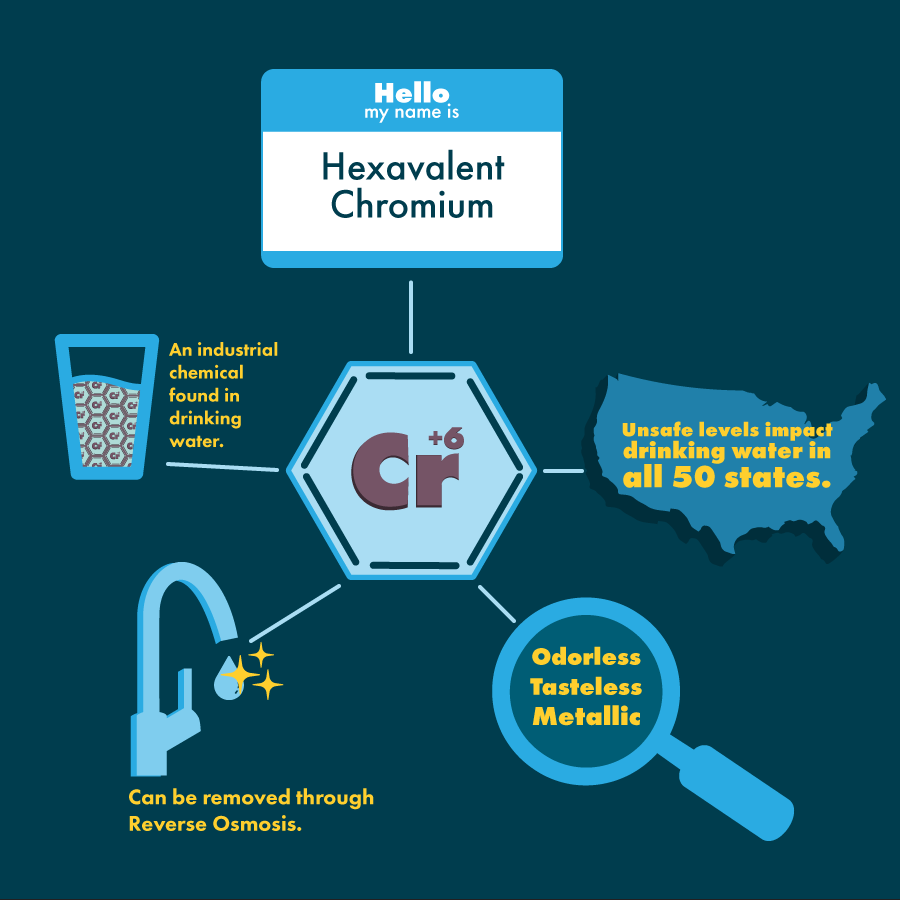
Preliminary tests have found that most of the total chromium in water is chromium-6, yet the EPA’s legal limit for total chromium is 100 ppb-5,000 times higher than California’s new proposed limit for chromium-6.Ĭurrently California is the only state that requires testing specifically for chromium-6.

According to its 2009 analysis of drinking water, 74 million people drink tap water polluted with “total chromium.” Total chromium includes trivalent chromium (which occurs naturally in many vegetables, fruits, meats, grains and yeast), as well as the toxic chromium-6. The utilities that service the 31 cities whose tap water contained chromium-6 provide water to over 26 million people.Īnd in fact, EWG believes the actual number of people drinking chromium-6 contaminated tap water is much larger. The highest levels of chromium-6 were found in Norman, OK which measured 12.9 ppb Honolulu, HA with 2.00 ppb Riverside, CA at 1.69 ppb Madison, WI at 1.58 ppb and San Jose, CA which measured 1.34 ppb. 06 ppb now all 31 cities with chromium-tainted water have levels higher than California’s new proposed limit of. In its tests, EWG found that 25 of the cities tested had levels of chromium-6 higher than California’s original proposed limit of. The Environmental Protection Agency (EPA) has classified chromium-6 as “likely to be carcinogenic to humans” when ingested through drinking water in a draft review of the chemical, but it does not require water utilities to test for it nor has it established safe legal limits for the chemical. 02 ppb because of new findings about the vulnerability of young children and sensitive populations to chromium-6 exposure. It is also present naturally in some minerals.Īfter the National Toxicology Program found that chromium-6 caused cancer in rats and mice in 2008, California proposed the establishment of a statewide legal limit of 0.06 parts per billion (ppb) of chromium-6 in drinking water. On December 31, the Office of Environmental Health Hazard Assessment of the California Environmental Protection Agency revised its proposed limit to. Used in the manufacture of stainless steel, textiles, anticorrosion coatings, and in leather tanning, it gets into drinking water through industrial pollution. The Environmental Protection Agency has a federal limit of 100 ppb for total chromium and no standard for chromium-6.Chromium-6 is highly toxic and has been found to cause allergic dermatitis, and stomach and gastrointestinal cancer in animals and humans. The state has had an MCL of 50 ppb for total chromium since the 1970s. And, because we have treatment facilities already in place, we know our customers’ health and safety will continue to be protected.Ĭhromium-6 is a subset of total chromium. Prior to installing treatment facilities, however, we thoroughly investigated treatment methods to meet the new standard as cost-effectively as possible.Īs DDW works to establish a new MCL and because of chromium-6’s risk to public health, the State Board has also encouraged water utilities that had already installed treatment facilities to continue treating the water for the contaminant. Because we have a duty to protect our customers’ health and safety, we installed treatment facilities at the water sources we needed to use to serve our customers. Although we challenged the timeline for compliance in an effort to reduce the cost impact to our customers, the compliance deadline remained under six months. When the MCL was originally established, the deadline for compliance was very short. Although the State Board removed the MCL for chromium-6 due to insufficient documentation on the economic feasibility of compliance, the State Board continues to believe that chromium-6 is a threat to public health and is working to establish a new MCL, which could be the same as the previous MCL.

Protecting our customers’ health and safety is our highest priority, and we have always been committed to meeting all water quality regulations set by the public health experts. After taking cost, method effectiveness, waste disposal, and raw water quality all into consideration, our crews installed strong base ion-exchange treatment facilities at each affected location to meet the standard while in effect. Water supplies in our Willows and Dixon Districts, and in our Salinas District’s Las Lomas and Oak Hills systems, exceeded the maximum contaminant level (MCL) without treatment. In 2014, the State Water Resources Control Board’s (State Board) Division of Drinking Water (DDW) adopted a new chromium-6 standard of 10 parts per billion (ppb) however, in August 2017, DDW rescinded the regulation due to adequate documentation on the economic feasibility of meeting the standard. Chromium-6, also known as hexavalent chromium, occurs naturally in many water sources.


 0 kommentar(er)
0 kommentar(er)
